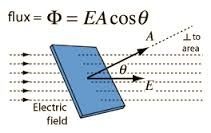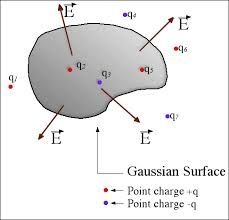ELECTRIC FLUX:-
Imagine the field lines to represent the field of charges at rest, nothing is flowing in electrostatic case, we still use the concept of flux. The definition of electric flux is same as that of velocity flux (that we discussed in previous blog) with E replacing v wherever it appears. Hence electric flux can be defined as:
Electric flux = E . A ........................(1)
As was the case with the velocity flux, the electric flux can be considered as a measure of the number of lines of the electric field that pass through the surface. Equation (1) can be applied only in the cases when E is constant in magnitude as well as in direction. .
Like the velocity flux, the flux of electric field is a scalar and its unit is Nm^2/C

GAUSS LAW:-
Now that we defined the flux of electric field vector through a closed surface, we are ready to discuss Gauss' law. Let us suppose we have a collection of positive and negative charges, which establish an electric field E throughout a region of space. We construct in that space an imaginary closed surface called a gaussian surface, which may or may not enclose some of the charges. Gauss' law which relates the total flux through this surface to the net charge enclosed by that surface, can be stated as:
"Total flux enclosed by a closed surface is equal to 1/epsylon not time the total charge enclosed by that surface."

We see that the Gauss' law predicts the electric flux to be zero for the surfaces which contain no charge. The magnitude of electric field is proportional to the number of field lines crossing an element of area perpendicular to the field. It is reasonable that the number of field lines passing through a surface should be proportional to the net charge enclosed by the surface.
The choice of the Gaussian surface is arbitrary. It is usually chosen so that the symmetry of the distribution gives, on at least a part of the surface, a constant electric field which can be easily calculated. In such a situation the Gauss' law can be used to evaluate the electric field.

APPLICATIONS OF GAUSS' LAW:-
Gauss' law can be used to calculate E if the symmetry of the charge distribution is high. For example for an infinite line of charges, infinite sheet of charges, a spherical shell of charges, spherically symmetric charge distribution .



